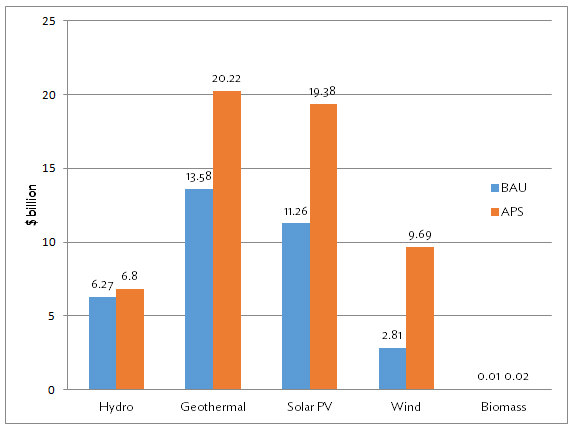
Some 134 million people in the Association of Southeast Asian Nations (ASEAN) region do not have access to electricity (IEA and ERIA, 2013). At the end of 2015, the ASEAN Community declared that the lack of power and energy access could threaten the region’s economic growth and its economic transition. Many industrial and commercial economic zones, and remote areas in ASEAN’s emerging countries that contribute to economic growth, are sometimes faced with an unstable energy supply. This can prevent companies and households from investing and providing economic activities, such as goods and services. Off-grid distributed energy systems (DES) using renewable energy could be a solution to this problem, thanks to the increasing availability of small power generation and renewable energy technologies.
Off-grid DES-related renewable energy sources include biomass, solar, and hydro, with generating capacities ranging from a few kilowatts to as much as 50 megawatts. Such renewable energy technologies can either be integrated into local distribution grids or used as stand-alone systems in areas where the extension of transmission lines is not economically viable.
As energy supply from off-grid DES-related renewable sources has a large potential to increase in emerging ASEAN countries, the Economic Research Institute for ASEAN and East Asia (ERIA) has attempted to estimate the off-grid DES-related renewable energy potential using both a business-as-usual (BAU) scenario and an alternative policy scenario (APS). A BAU scenario was developed for each ASEAN country to outline the current energy policies and the expected foreseeable future of energy policies and economy-wide energy consumption assuming no significant changes in government policies. An APS was set to examine the potential impacts of additional energy efficiency goals, action plans, or policies that are currently, or likely to be, under consideration. The results show that the electricity supply from off-grid DES-related renewable sources would increase from 65,608 gigawatt-hours under the BAU scenario to 91,854 gigawatt-hours in the APS (Figure 1). The investment opportunity estimated for the combined use of solar, wind, biomass, hydropower, and geothermal is about $34 billion for the BAU scenario and about $56 billion under the APS. Among the DES-related renewable energy sources, investments in solar and geothermal power are expected to double under the APS compared with the BAU scenario, while investment in wind energy is expected to increase more than threefold to meet the expected generation output by 2040.
Figure 1. Estimates of Off-grid Distributed Renewable Energy System Investment Opportunities by 2040

APS = alternative policy scenario, BAU = business as usual, PV = photovoltaic.
Source: Han (2016).
From the potential increase in off-grid DES-related renewable energy sources in ASEAN, it is also estimated that the CO2-emissions reduction in the ASEAN region as a result of the application of off-grid DES-related solar, wind, biomass, geothermal, and hydropower would be about 46.1 million metric tons in the BAU scenario and 64.6 million metric tons under the APS scenario.
But to realize the potential off-grid DES-related renewable capacity and investment, an enabling policy framework that provides a long-term government commitment and credible targets will be needed. ASEAN may need to consider a wide range of policy options and instruments, although it is already targeting a 23% share of renewable energy in primary energy supply by 2025. The following framework of policy options is worth considering:
- National policy design aims to provide a trajectory for the future energy mix. It includes a renewable energy target; a renewable energy law or strategy; a biomass and biofuels law or program; and a solar heating, solar power, wind, and geothermal law or program.
- Fiscal incentives aim to reduce the upfront cost by introducing fiscal policy instruments, such as exemptions of value-added tax, income tax, import and export duties, and local taxes; and the introduction of a carbon tax and accelerated depreciation.
- Grid access aims to give project developers confidence to invest through grid access priority and a transmission discount policy if electricity is produced from renewable energy.
- Regulatory instruments aim to provide incentives for investing in renewables through the implementation of energy policies, such as feed-in tariffs, feed-in premiums, auctions, net metering, and quotas.
- Finance aims to reduce risk for investors through the implementation of currency hedging, dedicated funds, eligible funds, and guarantees.
In conclusion, the increase in off-grid DES-related renewable energy supply in the ASEAN region will have multiple benefits for people and the environment. Its expansion and application could promote lower cost, more efficient energy access, and it could also address the challenging issue of electricity access for about 134 million people whose rights have been denied. Its application would also contribute to CO2 reduction at the ASEAN level by reducing emissions by as much as nearly 65 million metric tons in the APS scenario. ASEAN will enjoy quality growth by investing more in off-grid DES-related renewable energy sources.
_____
References:
Han, P. 2016. Analysis of Distributed Energy System and Implications for Electrification: The Case of ASEAN Member States. ERIA Discussion Paper, No. 2016-28. Jakarta: Economic Research Institute for ASEAN and East Asia.
International Energy Agency (IEA) and Economic Research Institute for ASEAN and East Asia (ERIA). 2013. Southeast Asia Energy Outlook. World Energy Outlook Special Report. Paris: IEA.
Photo: Bava Alcide57 at English Wikipedia [GFDL or CC BY-SA 3.0], via Wikimedia Commons




